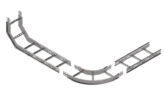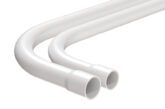
In this case study we find out why switching to Marshall-Tufflex’s MT Supertube was at the core of one contractor’s success when working on one of Britain’s most important new buildings.
Contractors tasked with delivering electrical services for what has been dubbed Britain’s most important new cultural building for almost 20 years have showcased the first-time installation of MT Supertube conduit encased entirely within the concrete core of a building.
£260m Switch House, an extension to London’s Tate Modern, features an exterior of latticed brickwork twisting around a multi-storey concrete core. Architects Herzog & de Meuron’s design included polished concrete walls and flush-mounted electrical accessories with – crucially – no voids for cable concealment in floors, walls or ceilings, dictating an in-situ cable containment solution.
Previous phases of the build made use of traditional galvanised conduit but contractors REL Building Services considered this approach costly and unworkable, opting instead for Marshall-Tufflex’s MT Supertube and, in doing so, breaking new ground in the application of the product.
Steve Jamieson, REL Technical Manager, said: “This was the first installation of this kind that we had ever been contracted to carry out. We not only learned a lot about alternative approaches to cable management installation but we also realised how valuable a flexible approach can be and the importance of interdisciplinary collaboration in addressing complex project challenges.”

The MT Supertube conduit, a seamless aluminium tube sandwiched between two layers of extruded LSOH polyethylene, was installed in stages, floor-by-floor, ahead of the concrete pour for each storey of the Switch House’s concrete core.
“There was an intensive design phase prior to any work taking place on-site and we were typically on-site for three weeks installing the cable management ready for the next pour,” said Steve. “We’d then stand down while the concrete formwork contractors (Byrne Group) prepared the next level.”
SWITCH HOUSE ‘SUPER’ STARS
MT Supertube has a number of features that make it the perfect choice for demanding construction projects such as Switch House:
1 It has the strength of steel but is pliable by hand – an invaluable feature for REL operatives bending the conduit around rebar.
2 It is lightweight and supplied in coils, making it easy to deliver to, and transport around, site. No lifting equipment or special considerations/permissions are required.
3 Its smooth inner surface allows cables to be inserted using a traditional draw wire, enabling cable pulls of up to 50m in length through a tube with no fittings. This minimises the risk of cables snagging during the build or any future electrical refurbishment.
4 MT Supertube is claimed to reduce installation costs by more than 50% when compared with standard galvanised steel conduit.
5 With MT Supertube there is no requirement for stock and dyes to thread the end of the conduit ahead of installing an accessory plate. Operatives simply place a screw into the side of the accessory box. Similarly a vice and bender isn’t required for MT Supertube installations, nor a hacksaw or grinder for cutting on-site. This saves time and minimises equipment requirements.
Planning and flexibility were key players in ensuring the success of this approach, with the MT Supertube installation having to dovetail perfectly with the concrete pour – and vice versa. When bad weather delayed the project both Byrne Brothers and REL had to be ready to move quickly to maintain the schedule. For each stage the cable management was measured, fabricated on the deck level, and threaded through the steel rebar, which proved a challenge given that the bars were close together in some areas.

“Only a flexible solution like MT Supertube could have been used as it allowed the team to bend lengths of conduit to fit into position around the steelwork and maximised the lengths we could use without a termination,” added Steve. “We allowed an excess of around two metres on each length to protrude beyond the concrete pour level so that we could connect the next sections to the existing installation after each concrete pour had cured.”
MT Supertube was secured to the steel rebar with cable ties to hold it in place during the concrete pour and each section signed-off by the design team ahead of the pour. The installation took 18 months to complete with a total of 6,000 man hours on site.








